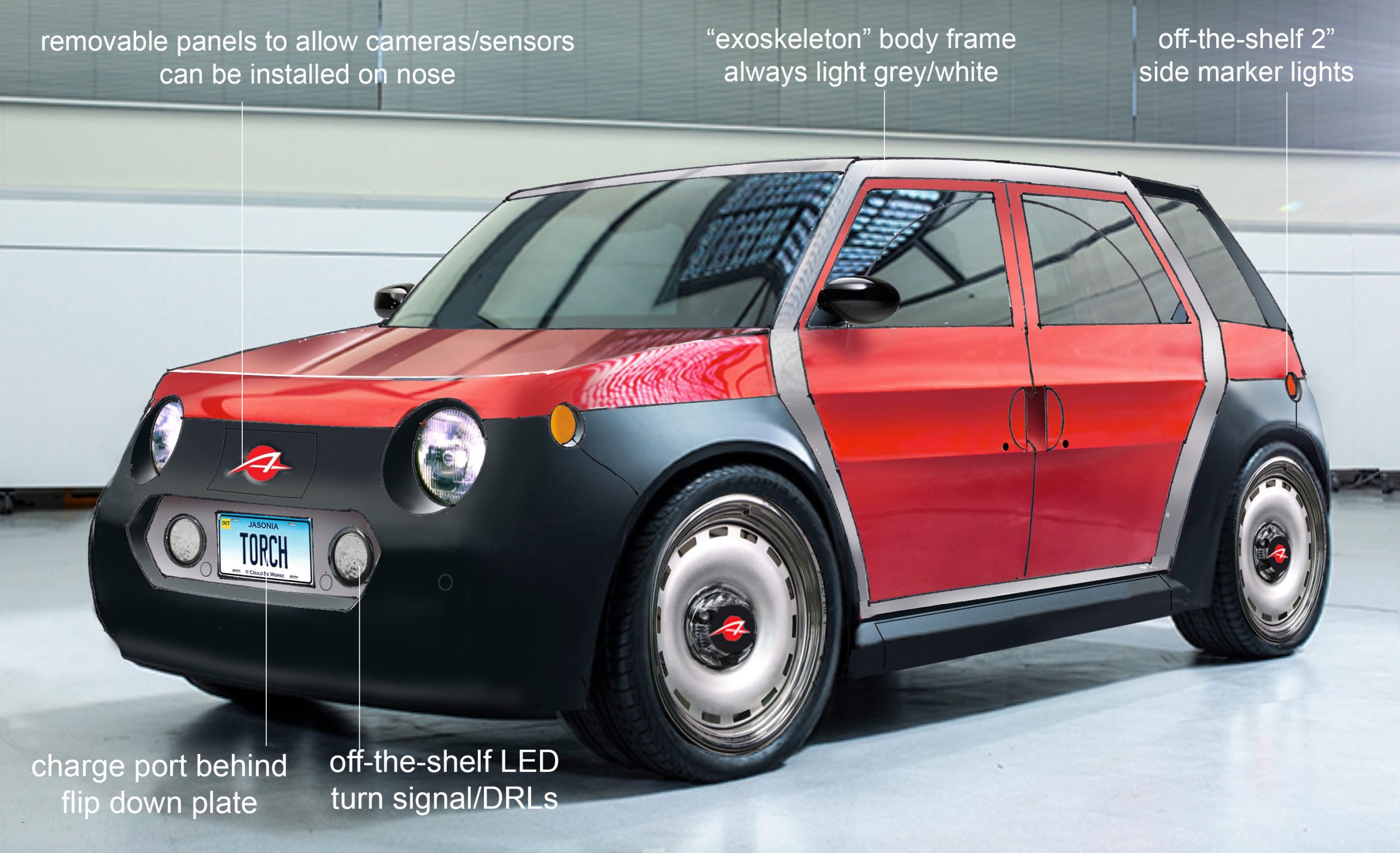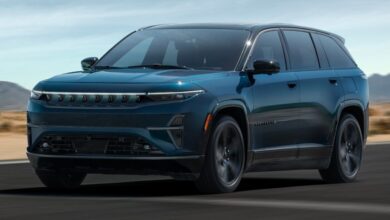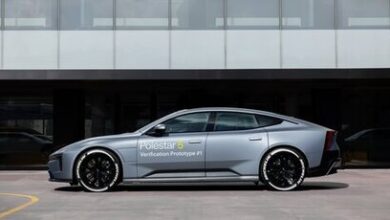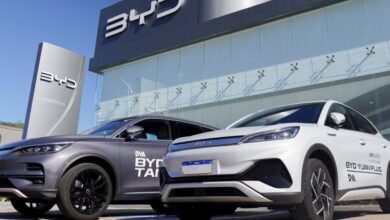This Is How To Make A $16,000 Electric Car

Just a few weeks ago, there was a little flurry of stories about how a Department of Energy official proposed a competition for American carmakers to come up with an EV that would sell for just $16,000. Keep in mind that the current cheapest EV in America right now, the 149-mile-range Nissan Leaf, costs nearly twice that amount at just under $30,000. Selling an EV for $16,000 is a big challenge, and will take some really innovative and out-of-the-box thinking to pull off.
The good news is that I’ve barely even seen the inside of that box, and neither has our own Bishop. And between the two of us, I think we have some pretty good ideas for making an incredibly affordable yet still useful and desirable EV. I don’t think this competition has officially begun or even if it will be A Thing at all, but that didn’t stop me from making a bunch of inarticulate demands of the Bishop and him processing those into some wonderful drawings of what I think are pretty damn good design ideas. So, with that in mind, let’s take a look at what sort of cheap EV the Bishop (let’s be honest, mostly Bishop) and I came up with.
![]()
I think there’s a crucial rule behind developing a successful inexpensive car, and that rule is honesty. All of the inexpensive, mass-market “people’s cars” that have become icons had this in common. Cars like the Volkswagen Beetle or Citroën 2CV or Renaut 4 or Fiat 500 never tried to be something they weren’t. They all had ideas that made sense for their own particular goals, even if those ideas and solutions may seem peculiar when compared to more mainstream cars. But they worked.
There’s a reason nobody is going to be collecting Nissan Versas in the future, but people still will be collecting vintage Minis, and that’s because the Versa was never comfortable with what it was, and always strove to be seen as a somehow-shrunken premium car that it very much wasn’t. The cheap cars that somehow captured our hearts and minds, the ones we all know and love, they never tried to be anything other than what they were, no matter how weird and cheap that was.

So, in designing our $16,000 EV, that is the philosophy I want to keep in mind. We don’t want to make something that’s trying to be an ensmallenated Tesla Model S or Lucid Air; whatever we make will openly and proudly have affordability as a key core principle. And, to go a little further, I’d like this car to be affordable as you own it, too! I want a car that’s forgiving of human failings and circumstance and chance and fate! If something bad happens, I want this car to work with you, and be cheap and easy to repair.
Modern cars are nightmarishly expensive to repair, for both mechanical problems and fixing damage from a wreck or other outside circumstances. This car will understand that, and try to be better. This car will also be easy to upgrade, on a timeline you as owner choose. It’ll be as modular as possible, with standardized parts that can be easily replaced and upgraded. It’ll be hackable and customizable and a rich aftermarket to support the car should be allowed to form and thrive; this is an idea I’ve dreamt of for quite a while, and I think now is the ideal time for it to happen.
With these ideas in mind, I made this rough sketch to explain what I was thinking to the Bishop:
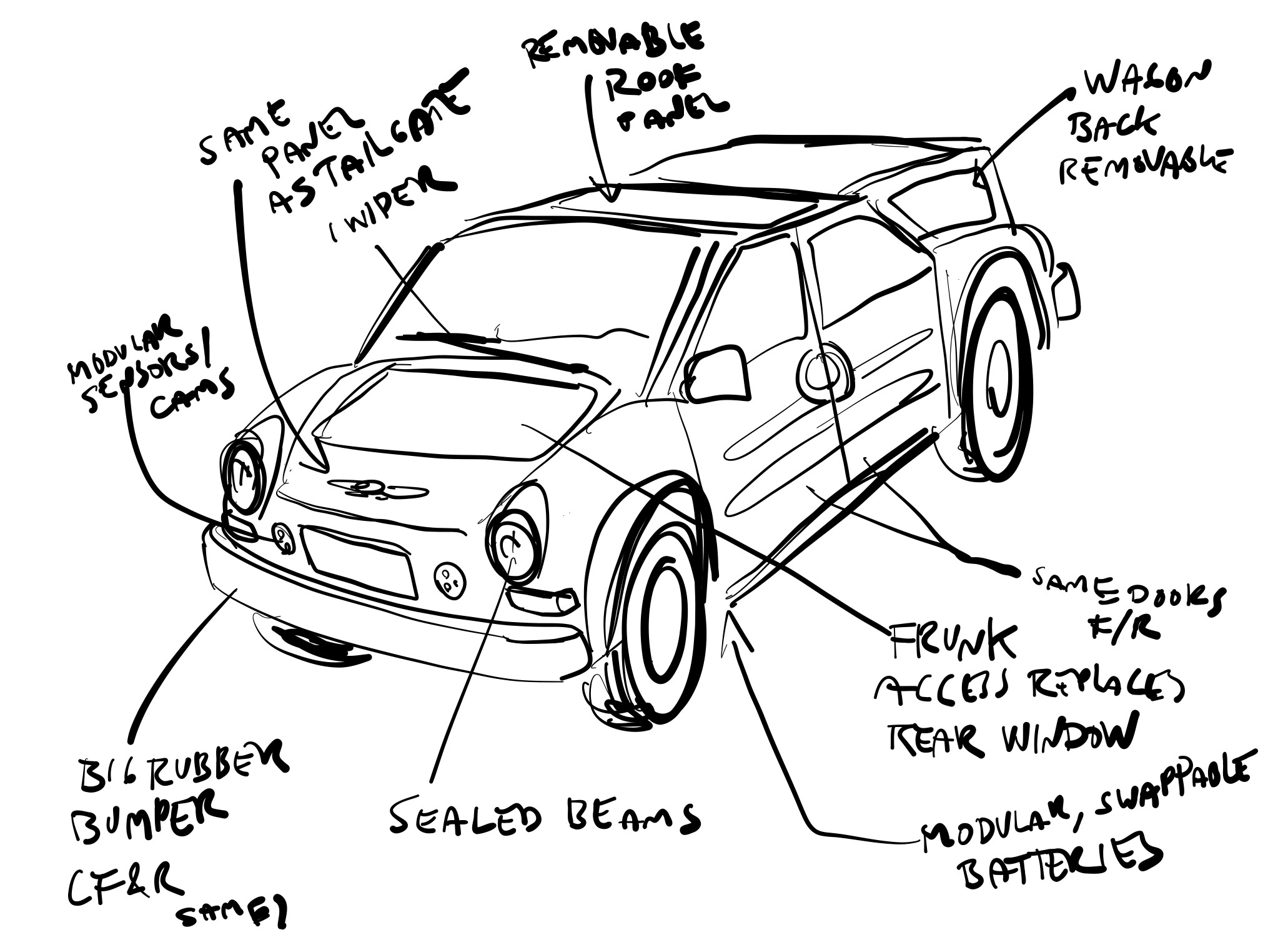
There are a few key features to note here:
- All lighting equipment is cheap, off-the-shelf stuff. The taillights, indicators, marker lights, and sealed-beam headlights are all out of parts bins. If you break one, you can order one online for dirt cheap or likely find a replacement at an auto parts store nearby. No more headlights that cost thousands of dollars to replace.
- The bumpers are big, unpainted things designed to take whacks and shrug them off.
- The need for unique body panels has been reduced as much as possible. The front and rear door stampings are identical parts, just reversed. The same goes for front and rear clips.
If the reversible panels idea sounds familiar, that’s because I cribbed it from those old masters of penny-pinching, AMC:
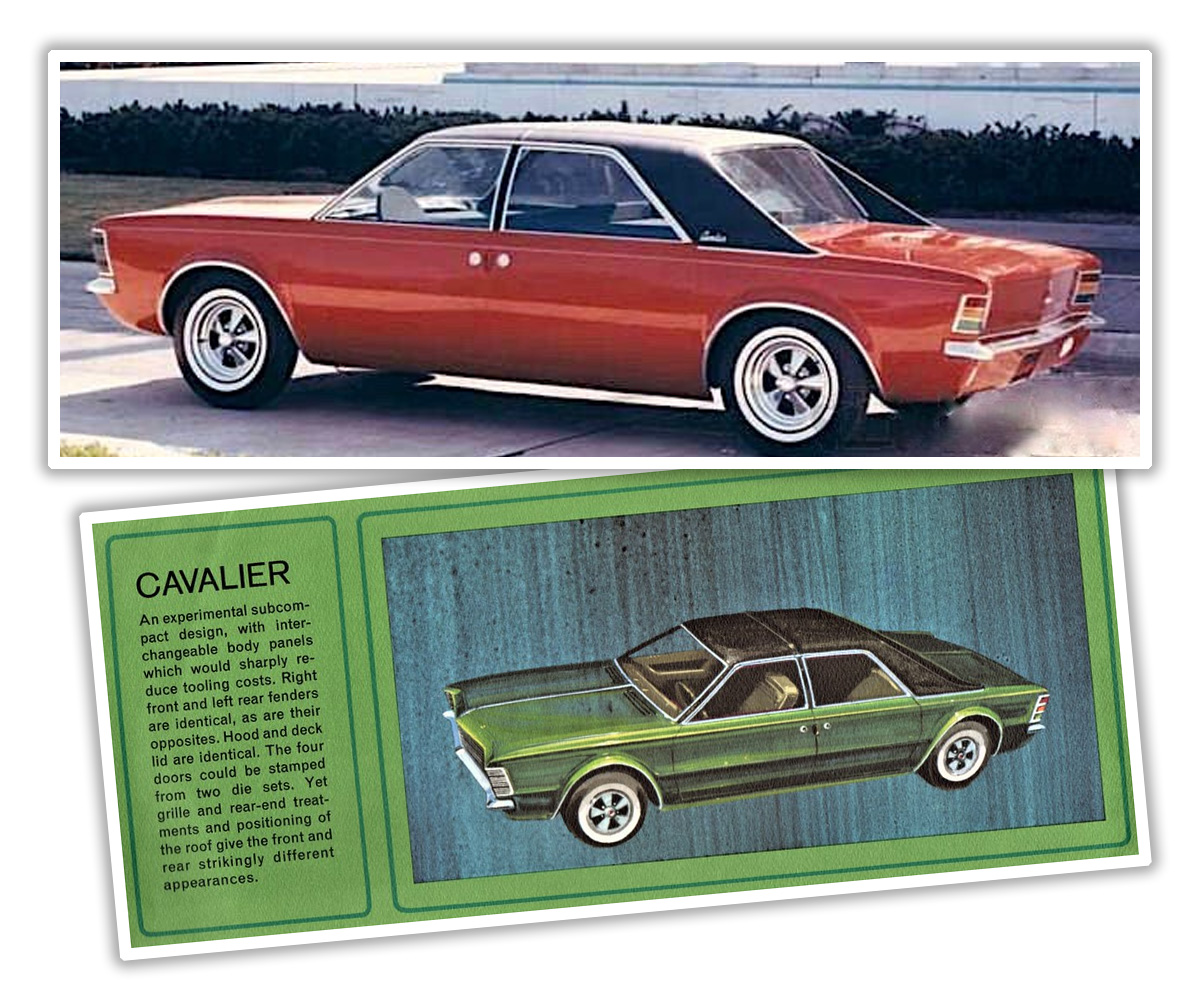
The AMC Cavalier concept car was all about reducing the number of stampings and dies; AMC only really implemented this in one stamping for front and rear bumpers on some of their cars, and the Cavalier eventually grew into the car that would be the Hornet, but the clever ideas in the original concept are certainly worth stealing.
From that crude sketch and a lot of back-and-forths with the Bishop, the car that I just now decided I want to call the Modulo took shape:
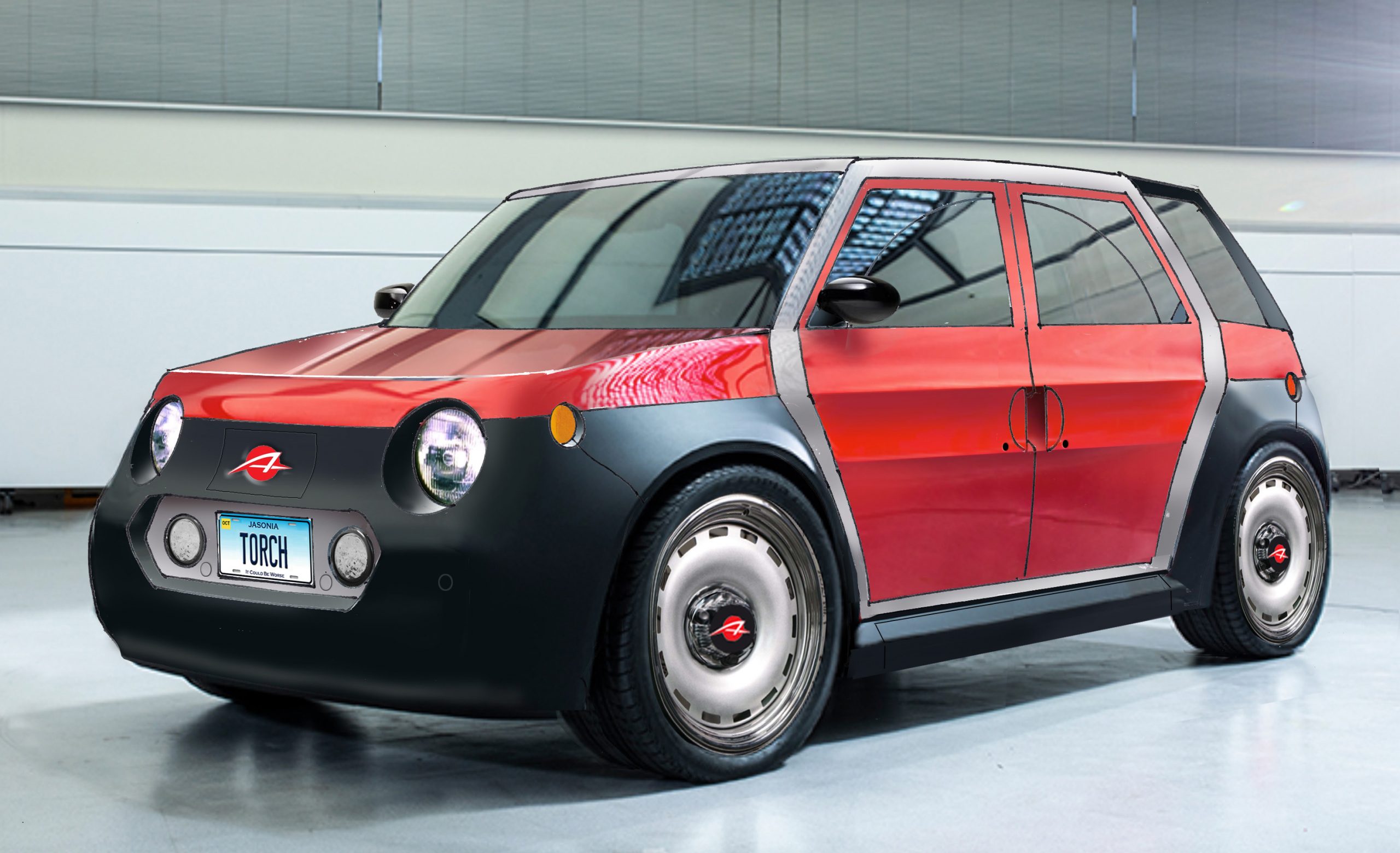
Here’s a view from the rear quarter:
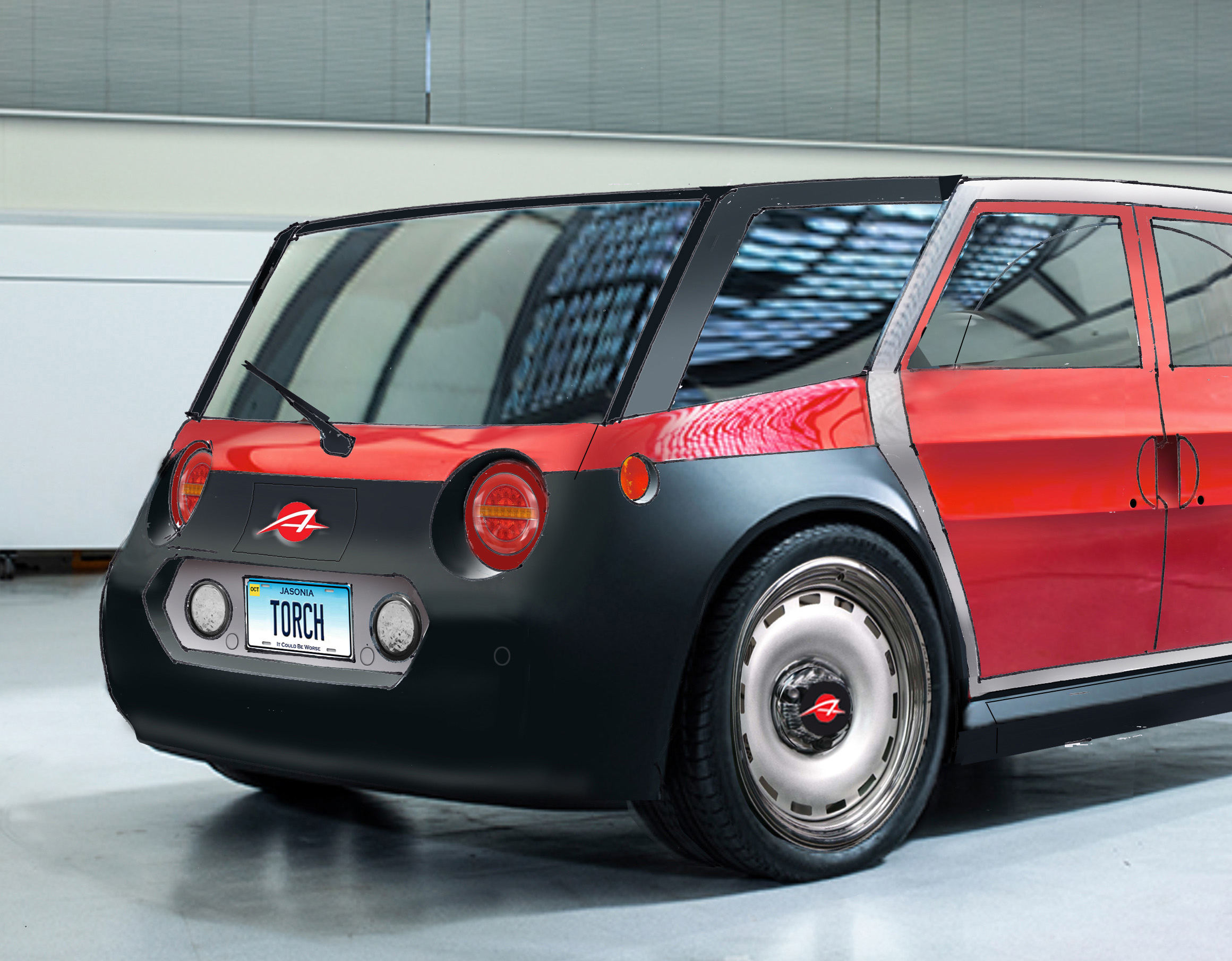
Sure, it looks a little funny, but I think for a car like this, that’s a good thing! All truly successful cheap, every-person’s cars have had a quirky look about them. Let’s get some callouts on here so you can see all the crucial features that a car like this I think needs to have:
Aside from the cheap, off-the-shelf lights, we have ports for sensors and cameras that can be added whenever the owner decides they want, say, dynamic cruise control or some sort of Level 2 driving assistance. You can buy the car without those features, then add them in later when you’re ready. That concept will carry throughout the car.
Here’s what the Bishop has to say about the panel-reuse concept and overall design theory:
“Here’s what you need to know about manufacturing: the tooling needed to make things like stamping out metal and molding plastic is expensive. Millions of dollars need to be spent up front before you’ll see any parts. At the same time, it goes without saying that making 50,000 parts will likely give you a cheaper per-piece price than making 25,000 pieces; you’ll pay for that tool much faster.
What that means is the fewer parts, and the more parts we can reuse, will make a product cheaper. The key to the Autopian car design is symmetry. Most cars are symmetrical left to right, but few are mirrored front-to-back; ours will do just that. Starting with the unibody frame underneath, we’ll use gigapress-formed parts where hopefully we could get the left and right to be exactly the same pieces welded together. All frames would be painted the same white or grey regardless of the colors of the other body panels we add to keep costs down. The fenders and hood that bolt on can, of course, be in different colors, preferably bright and fun ones.
There’s been talk about cars like the Rivian requiring expensive body repairs for even minor shunts. The Autopian car’s visible parts are all easily replaceable; just unbolt them and ad the new one in minutes.
The front and rear doors are mirror images of each other, so left front would be the same pressing as the right rear. Lastly, the bumpers are black plastic pieces that are used on both the front and rear of the car, with apertures that can accept different lights. That was a key requirement from Jason; he’s sick of hearing about $1000 lamp assemblies on cars and wanted the Autopian car to have lights you could buy almost anywhere inexpensively. Headlamps are old-school sealed beams, and taillamps are the “orange stripe” stock ones made by Hella and others (a reflector ring fills the space in the aperture).”
We have a main unibody frame that’s always one basic color, and the body panels provide the actual color of the car. And those panels are kept to a minimum! Same doors front and rear, same unpainted, rugged front and rear fascia panels, same fender/wheel arch panels front and rear. Here, look at the basic components:
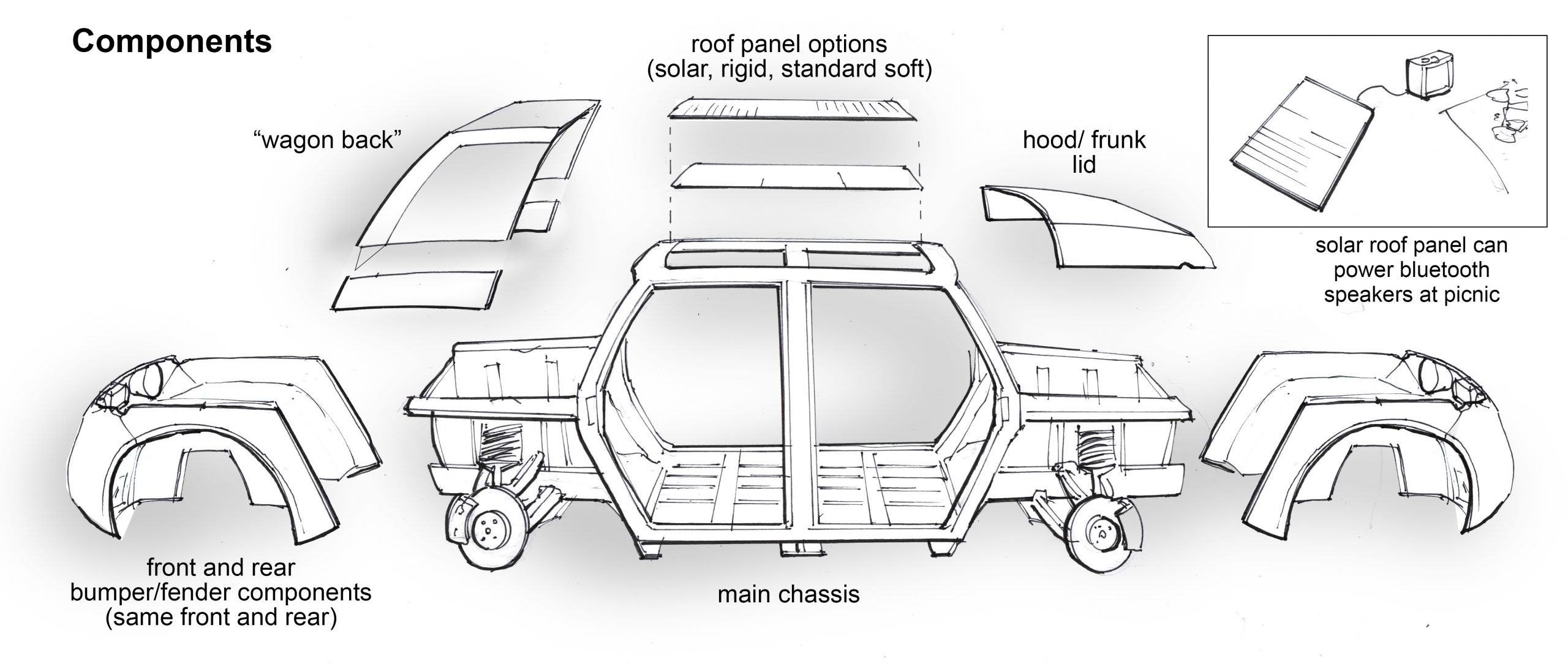
The motor and gearbox assembly will be mounted on the rear axle, close to other crucial drivetrain and charging components, which will be effectively under the rear trunk floor, and accessible via a removable floor panel. Up front, we have a mirror of this compartment but as a frunk, and below that floor will be more power and electronic hardware, along with the 12V battery.
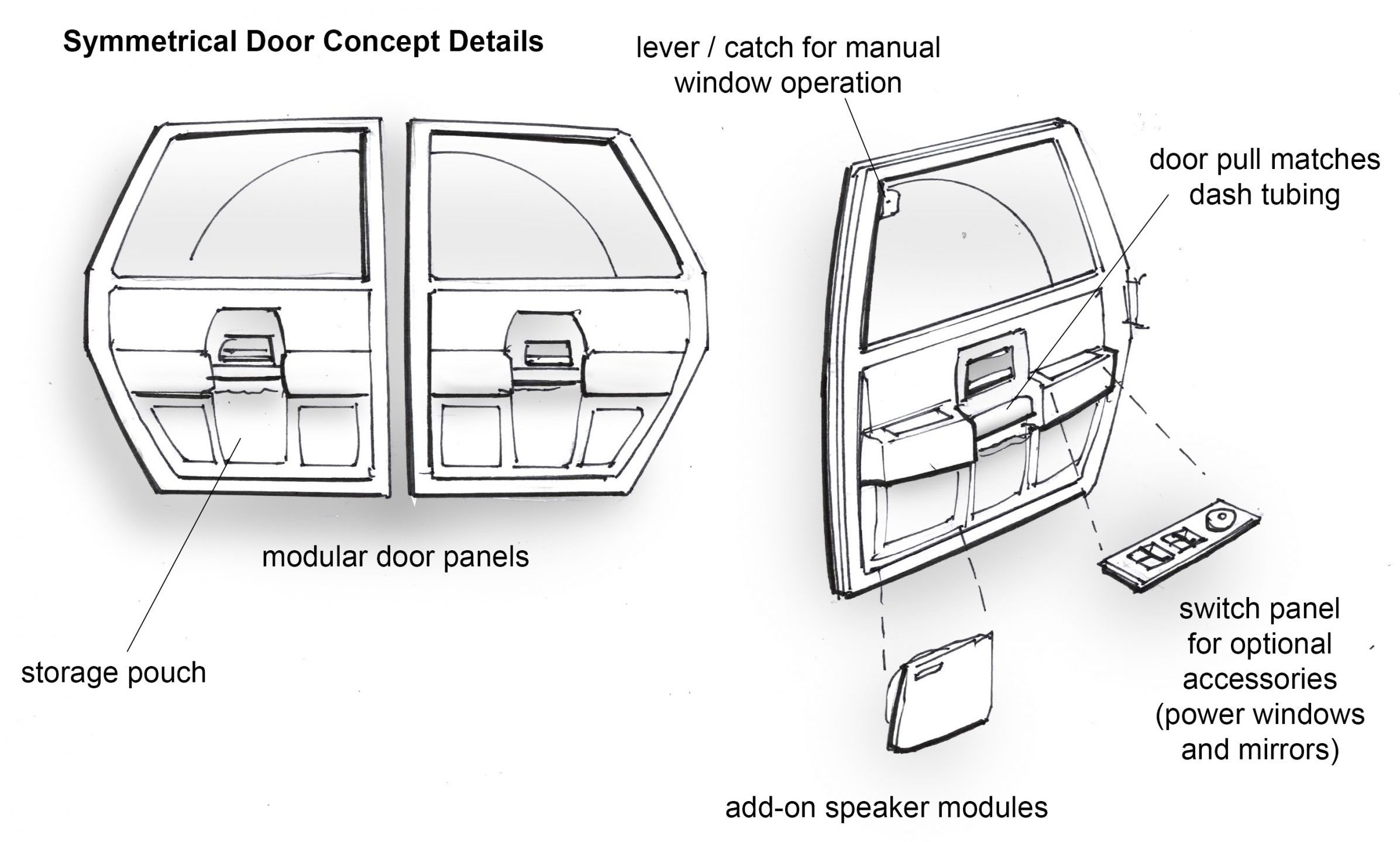
I especially like how the doors turned out; there are just two stampings, and both doors open at the B-pillar, meaning the rear doors are suicide-type doors. The windows open in circular arcs, and operate manually with simple catch-and-slide mechanics – unless an optional power window module is installed, which can be added on a door-by-door basis. Speakers can be added to any door panel, along with anything else the aftermarket decides to come up with.
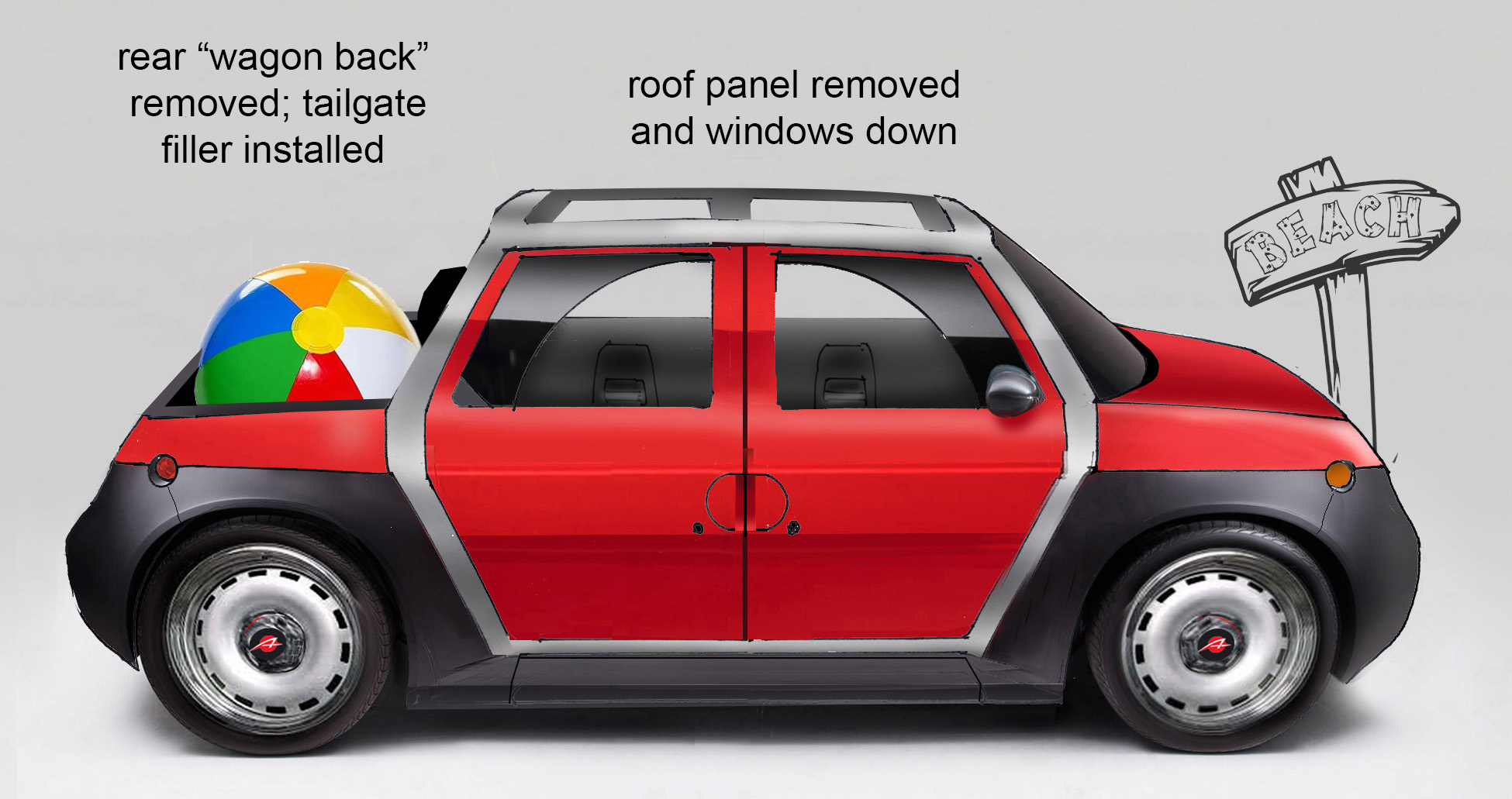
The rear “wagonback” cover can be removed easily as well, transforming the rear cargo area into an open bed, like a small truck. Here’s more from the Bishop:
“Naturally, the Autopian car isn’t exactly the same front and back; the front would have a typical hood and windshield while the rear is covered by a “wagon back” style hatch. My guess is that we could offer a standard “trunk lid” rear or a “fastback” style roof for those that prefer something different. The roof is a wide open hole; a collapsible, removable canvas top would be standard. You could upgrade to a multi-piece rigid unit or even a solar panel one to charge batteries and power your bluetooth speaker at a picnic or beach. Speaking of beach, after removing the roof, you could even unbolt the rear “wagon back” hatch for a full open style similar to what you could do with a 1986 Nissan Pulsar NX (and like that car a canvas cover could be offered in case it starts to rain while the “wagon back” is back at home).”
Another thing I demanded of the Autopian Modulo is that it should have removable, swappable batteries. I’ve thought that EV batteries should be easy to remove and swap out as an alternative to charging or for maintenance purposes for years. The EV industry has not agreed with me, and has been integrating battery packs ever more tightly into the structure of its electric cars. This has some engineering advantages, but it also means that replacing a bad battery pack is extremely costly major surgery.
While EV battery life is generally better than was expected in the early modern EV era, it’s still not a question of if you’ll eventually have to replace an EV battery, it’s when. I can’t abide the idea that a car should have such a financially crippling time bomb embedded in it, so the Autopian Modulo will have modular, standardized battery packs.
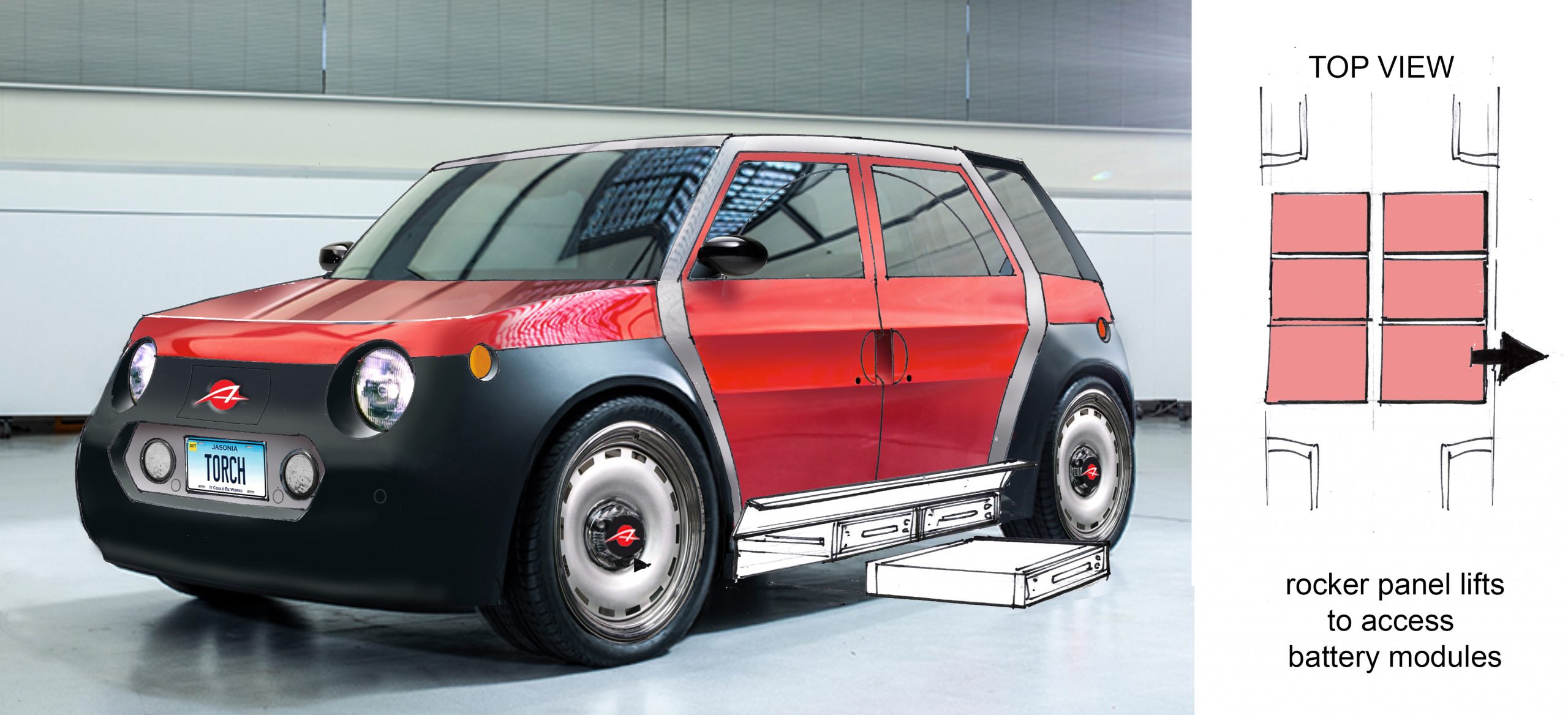
There will be slots for six batteries, three per side, and they slide out from under the rocker panels. The car can run with as few as one pack if needed and the base model will likely be sold with two by default, but buyers can add more if desired. I would hope each module is capable of delivering at least, say, 40 miles, for a total range of 240 miles with a full six-pack on board. Even if the individual batteries only get 30 miles per pack, the total would still be 180 miles, which is still decent enough for an entry-level EV like this.
While you can use conventional EV chargers and fast chargers to charge the Modulo, there’s also the option of battery swapping. They’re already doing something much like what we’re imagining with scooters in China:
We’re imagining something similar for the Modulo, ideally done in an open-source way, so any number of companies could operate Modulo-compatible battery swap stations that meet dimensional, voltage, and connector standards. A typical station may look like this:
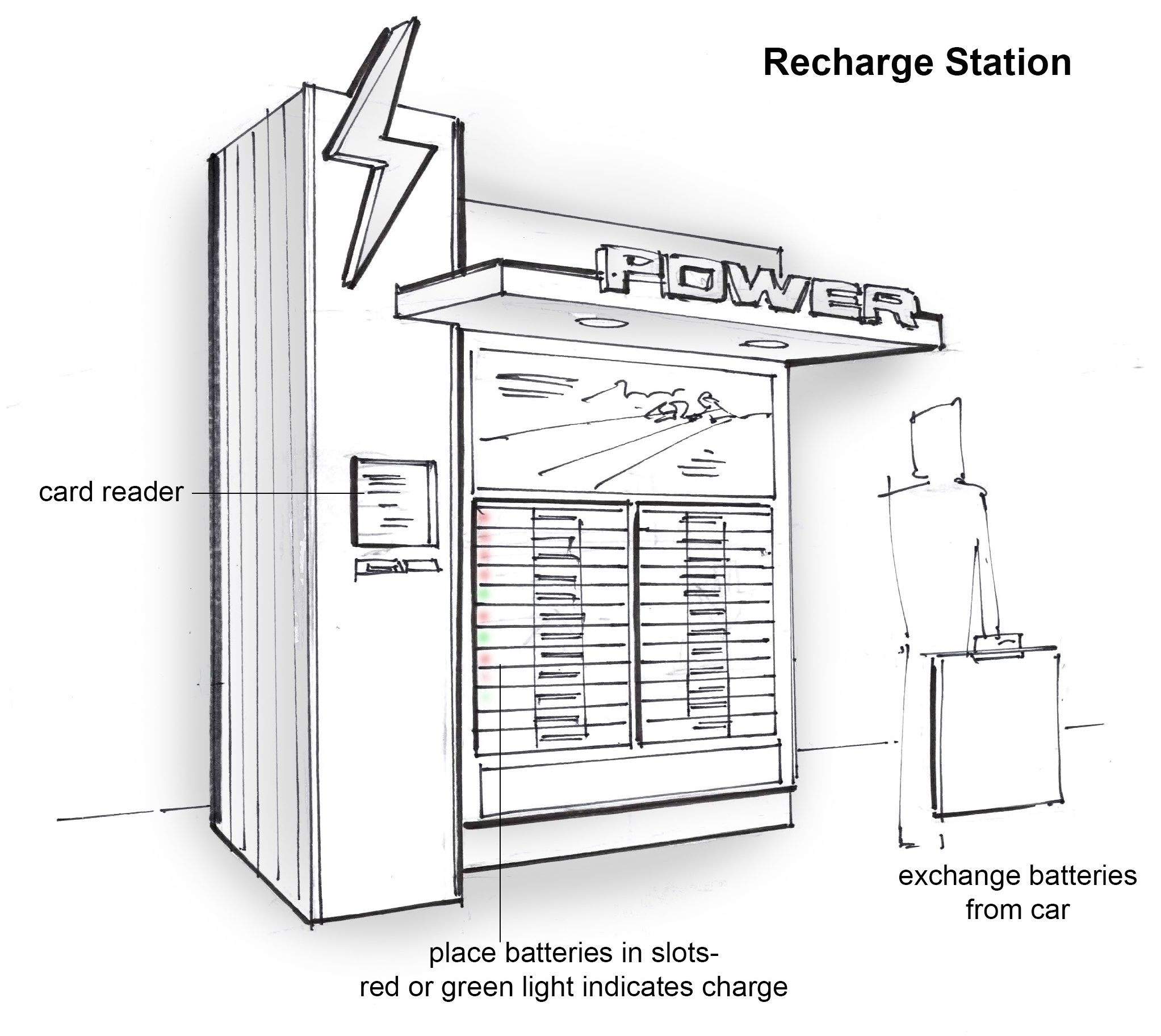
They would be sort of like propane tank stations are at countless gas stations across the country: you’d pay for the “rights” to however many batteries you want, and you just swap them out when they’re depleted, and back into the system they go. When they get too degraded, they’re pulled from circulation and go on to become wind farm load levelers or some similar use. This way, you may own, say, four “batteries” but you never actually have to physically own a battery that’s constantly and slowly degrading.
Plus, you can upgrade your range as needed. If your daily life works just fine with three batteries, then that’s all the battery rights you need to own, except for the three times a year you take big road trips, and in those times you temporarily pay for access to three more batteries. It’s flexible and easy and you’re never going to be dragging around battery weight you don’t need and never will be stuck having to shell out $20,000 for a whole new battery pack.
The inside of the Modulo is based on the same principles of modularity, ease of use and repair, and ready upgradability. The HVAC unit is optional and mounted in the center console; this can be a basic unit with just a heater or a full HVAC unit with A/C. The HVAC distribution pipes form the structural basis of the whole dashboard, with other components mounted to them.
The instrument cluster and center-stack infotainment displays and touchscreens are both cheap, off-the-shelf Android (or iOS, why not?) tablets running an app for their specific functions. They connect to the car for power and data with standardized connectors and can be replaced or upgraded at will. They’re not necessarily automotive grade, but if they fail after a few years, they’re cheap to replace. Plus, as technology improves, better tablets capable of running updated infotainment or instrument cluster software can be used. Systems like Apple CarPlay or Android Auto can be used in lieu of the center stack infotainment tablet if desired, too.
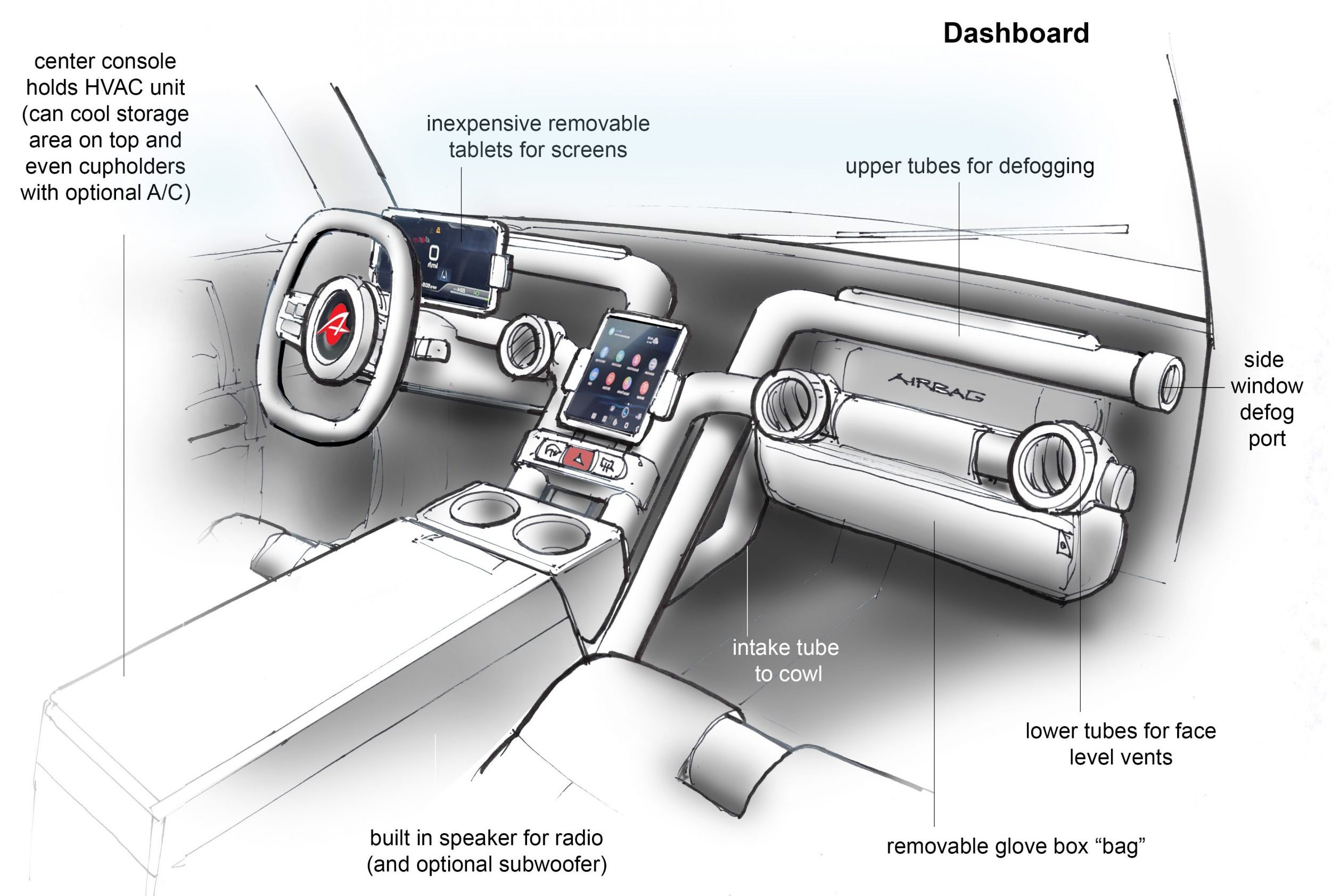
Like the rest of the car, the modular interior would be designed so that aftermarket options would be available, so if you wanted, for example, nicer leather seats, you could swap out the more basic seats the car came with for fanicer ones whenever you wanted.
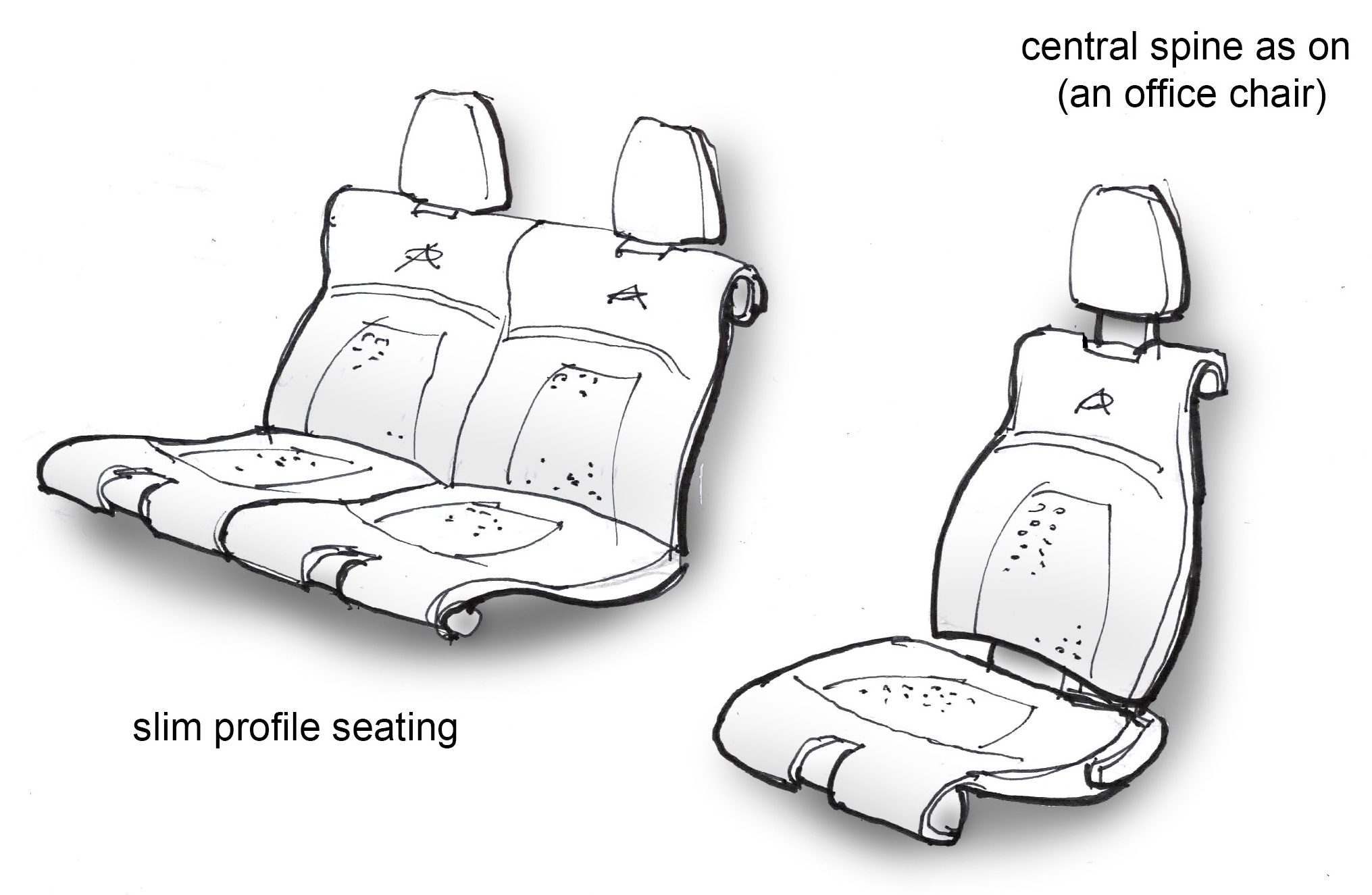
The seats, like everything else the owner has access to on the car, would be designed to be easy to remove and install with only basic skills and tools. This would go for as many elements of the car as possible. Flooring may start as rubber matting, but that could be removed and replaced with carpet, using the same basic fasteners. The same goes for interior door panels or headliners or whatever.
This is the way we can get to a $16,000 useful, desirable EV. Maybe that $16,000 edition is the most basic one, with rubber flooring and manual windows and just two battery packs and cheap tablets and no extra cameras and sensors and so on. But what makes the Modulo different from most cars is that you can buy the $16,000 basic one and over the years, as your fortunes improve, you can easily add and modify your car until you’ve doubled the range, got better seats, full carpet, A/C, adaptive cruise, whatever. And you did it on your pace, and installed every upgrade on your own, with ease.
If you get in a small wreck, it’s not a devastating thing; it’s a little bit of money and a weekend’s worth of time to make things right again. As the car ages, you’re not stuck with a degrading battery and vanishing range; you just go to your nearest battery swap station and get yourself some new modules.
I think making a good, cheap EV needs to be a pretty radical departure from the sorts of EVs we see now, and needs to be something that looks at the entirety of the ownership experience, not just something that looks sleek and crows about range and 0-60 times. It needs to be something that’s not just affordable at the point of sale but stays affordable throughout its long and devoted life with you.
It’s time for the Autopian Modulo. Are you listening, Advanced Research Projects Agency – Energy (ARPA-E)? Go ahead and officially issue that $16,000 challenge! We’re ready! Well, unless we have to actually build these, in which case, um, we don’t have those resources. But we’re open to talk!

This Malaise-Era Chrysler Had The Most Ridiculous Rear Door Window Solution Ever
The Best Stories From ‘The Bishop,’ A Mysterious Designer Who Writes Weird Car Things Without Us Even Asking
Let’s Imagine If Defunct Automaker Studebaker Had Saved Itself Using NSU’s Rotary Engines
